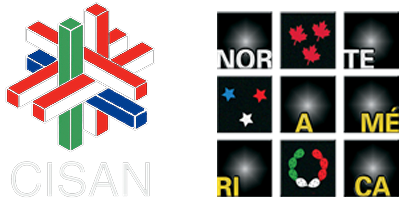Abstract
With a tradition spanning six decades, in North America, the practice of scientific communication has been seen as a direct responsibility of academia, despite the scarcity of models that aim to measure its impact. This article develops a quantitative approach to present the design and validation of an instrument to assess the academic practice of scientific communication, which incorporates factors of dissemination, outreach, and teaching practice in the use of scientific communicative products for teaching and learning. The instrument was integrated into seven scales and 30 indicators over a sample of 233 educators from 13 universities located in the United States of America, Canada, and primarily, Mexico. The reliability results were consistent, showing more than acceptable coefficients. Correlation analyses reveal that the dimensions of the academic practice of scientific communication are associated in a directly positive and significant way ranging from moderate to strong.
References
Ashcraft, Laura; Quinn, Deirdre & Brownson, Ross
“Strategies for effective dissemination of research to United States policymakers: a systematic review”. ImplementationSci (89) pp. 9-17 https://doi.org/10.1186/s13012-020-01046-3
Baker, Beth
“Biologists as Communicators: Lessons from social science can help researchers get their message across”, BioScience, Volume 69, Issue 2, February 2019, pp. 101–107, https://doi.org/10.1093/biosci/biy158
Brownell Sara; Price, Jordan & Steinman, Lawrense
“Science communication to the general public: Why we need to teach undergraduate and graduate students this skill as part of their formal scientific training”. Journal of Undergraduate Neuroscience Education, 12(1), pp. E6–E10
https://www.ncbi.nlm.nih.gov/pmc/articles/PMC3852879/
Callon, Michel
“The role of lay people in the production and dissemination of scientific knowledge”. Science, Technology and Society, 4(1), pp. 81-94.
https://doi.org/10.1177/0971721899004001
Castelfranchi, Yurij y María fazio
“Comunicación pública de la ciencia”. Montevideo: Organización de las Naciones Unidas para la Educación, la Ciencia y la Cultura (UNESCO). París: UNESCO.
Cheung, Gordon & Wang, Chang
“Current Approaches for Assessing Convergent and Discriminant Validity with SEM: Issues and Solutions”. Academy of Management Proceedings, 2017(1). https://doi.org/10.5465/AMBPP.2017.12706abstract
Cifuentes, Rocío
“Para provocar la conversación: la práctica en la formación de los trabajadores sociales. Documento de trabajo”. Manizales: Universidad de Caldas.
Cole, Lisa; Reichmann, Stefan & Ross-Hellauer, Tony
“Toward equitable open research: stakeholder co-created recommendations for research institutions, funders and researchers”. Royal Society Open Science, 10(2), pp. 2-21. https://doi.org/10.1098/rsos.221460
Contreras-Cázarez, Carlos; León-Duarte, Gustavo
“Análisis factorial de un modelo de socialización y confianza en la dependencia de Internet en estudiantes de secundaria”. Revista Electrónica de Investigación Educativa, 21, 1-13. https://doi.org/10.24320/redie.2019.21.e25.2112
Contreras-Cázarez, Carlos; León-Duarte, Gustavo & Durazo, Luisa
“Variables predictoras de riesgo frente a los derechos del infante en la era digital. Un estudio de México y España”. Edutec, Revista Electrónica de Tecnología Educativa, (73), 122-139. https://doi.org/10.21556/edutec.2020.73.1549
Contreras-Cázarez, Carlos
“Métricas de un instrumento para evaluar la competencia informacional autopercibida por estudiantes universitarios”. Investigación Bibliotecológica: Archivonomía, bibliotecología E información, 37(94), 33–50. https://doi.org/10.22201/iibi.24488321xe.2023.94.58674
Cordero, Aixchel; Picazo, David y Sandoval, Angelica
“Los medios de comunicación en México como plataforma educativa para la divulgación científica”. En Discurso mediático y audiencias: una aproximación crítica a la comunicación de masas, Mayte Donstrup, ed., E. Ediciones, pp. 77-98.
Cruz-Mena, Javier.
“La comunicación pública de la ciencia: entre el principio de autoridad y la sociedad del argumento”. En, La pandemia de la COVID-19 y sus riesgos globales, Linares, Jorge y Zapata, Miguel (Ed), México: UNAM, pp. 165-180.
Davis, Rachel & D’Lima, Danielle
“Building capacity in dissemination and implementation science: a systematic review of the academic literature on teaching and training initiatives”. Implementation Sci 15, 97. https://doi.org/10.1186/s13012-020-01051-6
Fernández, Ernesto; Bello, Alessandro y Massarani, Luisa.
“Políticas públicas e instrumentos para el desarrollo de la cultura científica en América Latina”. Laboratorio Tecnológico del Uruguay - UNESCO, 2016.
Fleming, Oscar, et al.
“Putting Implementation Science into Practice: Lessons from the Creation of the National Maternal and Child Health Workforce Development Center.” Maternal and child health journal, 23(6), pp. 722–732. https://doi.org/10.1007/s10995-018-02697-x
Galeano, Claudia; Rosero, Ketty y Velásquez, Paula
“Reflexiones y retos de la práctica académica en trabajo social”. Prospectiva. Revista de Trabajo Social e Intervención Social Núm. 16, pp. 131-160.
https://dialnet.unirioja.es/servlet/articulo?codigo=5857495
Havelock, Ronald
A Comparative Study of the Literature on the Dissemination and Utilization of Scientific Knowledge. Michigan University - Office of Education.
Herrera, Susana.
"Comunicación pública de la ciencia y problemáticas sociales. El comunicador de la ciencia en el trabajo transdisciplinario con grupos vulnerables." Revista Mexicana de Comunicación 145 (2020): 2.
Herrera, Susana y Orozco, Carlos, Coords.
Comunicar ciencia en México : prácticas y escenarios. Guadalajara, México: ITESO.
León-Duarte, Gustavo
“Características estructurales de la producción ALAIC. Una aproximación al conocimiento comunicativo del gt-17”. Comunicación y Sociedad, 3(6), 131–158.
https://doi.org/10.32870/cys.v0i6.3981
León-Duarte, Gustavo
“Teoria intermediária na comunicação: elementos necessários para uma abordagem da comunicação como cultura”, MATRIZes, 15(2), p. 95–118. DOI:10.11606/ISSN.1982-8160.V15I2P95-118.
León-Duarte, Gustavo
“Cruzamentos e limites na pesquisa sobre comunicação: o sentido prático interdisciplinar”, MATRIZes, 17(3), p. 117–140. doi:10.11606/issn.1982-8160.v17i3p117-140.
León-Duarte, Gustavo; Contreras-Cázarez, Carlos y Meneses, Erika
“Dimensión y validez convergente. Sentidos y significados de la producción y la difusión científica en ambientes universitarios”, Región y Sociedad, 33, p. e1452. doi: https://doi.org/10.22198/rys2021/33/1452
Leshner, Alan
Public engagement with science. New York: Science. https://doi.org/10.1126/science.299.5609.977
Macfarlane, Bruce
“The Morphing of Academic Practice: Unbundling and the Rise of the Para-academic”. Higher Education Quarterly, 65: 59-73. https://doi.org/10.1111/j.1468-2273.2010.00467.x
Massarani, Luisa
“Estado del arte de la divulgación de la ciencia en América Latina”. JCOMAL 1(01). https://doi.org/10.22323/3.01010201
Massarani, Luisa y Castro, Ildeu.
“Divulgación de la ciencia: perspectivas históricas y dilemas permanentes”. Quark, no. 32, pp. 30-35, https://raco.cat/index.php/Quark/article/view/55031
Mendizábal, Victoria
“De la torre de marfil a la arena pública: El papel de los científicos en la comunicación de la ciencia y la tecnología”. Communication papers: media literacy and gender studies, 7(13), pp. 173-196.
National Academies of Sciences, Engineering, and Medicine (NAS) (Ed.)
Communicating science effectively: A research agenda. The National Academies Press.
Navarro, Lizy
La comunicación de la ciencia en la pandemia por COVID-19 y sus divulgadores. Emerging Trends in Education, 4(7), pp. 13-27 https://doi.org/10.19136/etie.a4n7.4456
Organización de las Naciones Unidas para la Educación, la Ciencia y la Cultura
Declaración de la Ciencia y el Uso del Conocimiento Científico, adoptada en la Conferencia Mundial de la Ciencia de 1999. Budapest: UNESCO. Disponible en: http://www.unesco.org/science/wcs/esp/declaracion_s.htm
Pamies, Marcial; Gomariz, María y Cascales, Ángeles.
“Factores condicionantes de la transferencia de la formación permanente del profesorado no universitario”. Revista de Educación a Distancia (RED), 22(69). https://doi.org/10.6018/red.486801
Prieto-Castillo, Daniel
“Comunicación educativa en el contexto latinoamericano”. Psychosocial Intervention, 7(3), pp. 329-346.
Rauchfleisch, Adrian & Schäfer, Mike
. Structure and development of science communication research: co-citation analysis of a developing field. Journal of Science Communication, 17(03), A07
https://doi.org/10.22323/2.17030207
Sánchez-Mora, Carmen, et al.
“Public communication of science in Mexico: past, present and future of a profession”. Public Understanding of Science, 24(1), pp. 38-52.
Sánchez Mora, Carmen ; Cruz-Mena, Javier y Sánchez Mora, Ana
“El papel de la comunicación de la ciencia en la pandemia actual”. JCOM – América Latina 04 (01), pp. 3-22 https://doi.org/10.22323/3.04010401.
Sánchez-Mora, María del Carmen y Sánchez-Mora, Ana María.
“Tendencias en la comunicación de la ciencia: la transformación inesperada de una idea”. Revista Mexicana de Comunicación, 2021, no 148, pp. 3-13.
Sanz-Lorente, María y Guardiola, Rocio
“Comunicar la ciencia”. HospDomic, 3(2), pp. 173-83.
http://doi.org/10.22585/hospdomic.v3i2.57
Sung, HeeKyung
UNESCO World Culture Report. In, Encyclopedia of Quality of Life and Well-Being Research. Maggino, Filomena (eds). Springer, pp. 7345–7346 https://doi.org/10.1007/978-3-031-17299-1_3081
Taherdoost, Hamed; Sahibuddin, Shamsul & Jalaliyoon, Neda
“Exploratory Factor Analysis; Concepts and Theory”. Advances in Applied and Pure Mathematics, 27, pp. 375-382. https://go.revistacomunicar.com/Tgo85Z

This work is licensed under a Creative Commons Attribution-NonCommercial-NoDerivatives 4.0 International License.
Copyright (c) 2024 Gustavo Adolfo Leon Duarte, Carlos René Contreras Cázares, Erika Carolina Meneses Jurado


